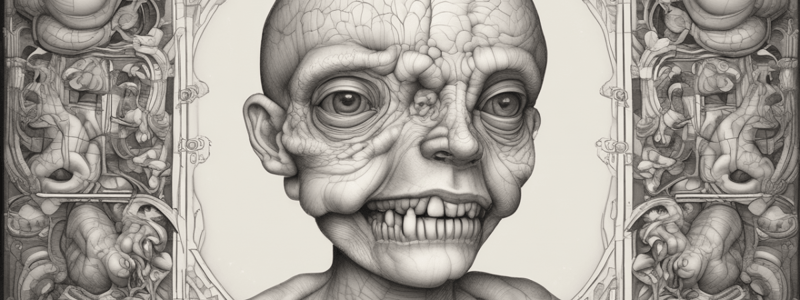Podcast
Questions and Answers
Congenital abnormalities can be classified into only two categories, major and minor.
Congenital abnormalities can be classified into only two categories, major and minor.
False (B)
All congenital abnormalities are structural/morphological abnormalities.
All congenital abnormalities are structural/morphological abnormalities.
False (B)
Anencephaly is a severe congenital defect that can be surgically corrected.
Anencephaly is a severe congenital defect that can be surgically corrected.
False (B)
Congenital hip dislocation is a severe congenital defect that can lead to death if not surgically corrected.
Congenital hip dislocation is a severe congenital defect that can lead to death if not surgically corrected.
Undescended testis is a severe congenital defect that requires immediate surgical correction.
Undescended testis is a severe congenital defect that requires immediate surgical correction.
Cleft lip is a mild congenital defect that does not require surgical correction.
Cleft lip is a mild congenital defect that does not require surgical correction.
In Hypoplastic Left Heart Syndrome, the right ventricle is underdeveloped.
In Hypoplastic Left Heart Syndrome, the right ventricle is underdeveloped.
Atrial septal defect is a type of ventricular septal defect.
Atrial septal defect is a type of ventricular septal defect.
Tetralogy of Fallot is a type of septal defect.
Tetralogy of Fallot is a type of septal defect.
Cyanosis is caused by an increased flow of oxygenated blood to the lungs.
Cyanosis is caused by an increased flow of oxygenated blood to the lungs.
Surgical repair of Tetralogy of Fallot is usually unsuccessful.
Surgical repair of Tetralogy of Fallot is usually unsuccessful.
In Encephalocele, the brain and meninges herniate through a defect in the posterior vertebral arches.
In Encephalocele, the brain and meninges herniate through a defect in the posterior vertebral arches.
The proportion of congenital abnormalities with a genetic origin is estimated to be around 60% of total congenital abnormalities.
The proportion of congenital abnormalities with a genetic origin is estimated to be around 60% of total congenital abnormalities.
Down syndrome is an example of a numerical chromosomal aberration.
Down syndrome is an example of a numerical chromosomal aberration.
Environmental causes are responsible for about 50% of all congenital abnormalities.
Environmental causes are responsible for about 50% of all congenital abnormalities.
Endosulfan is a non-toxic pesticide that has no adverse effects on human health and the environment.
Endosulfan is a non-toxic pesticide that has no adverse effects on human health and the environment.
Congenital anomalies involving the heart have the highest incidence at 10/1000 live births.
Congenital anomalies involving the heart have the highest incidence at 10/1000 live births.
Anencephaly is a type of neural tube defect that affects the spine.
Anencephaly is a type of neural tube defect that affects the spine.
Cri-du-chat Syndrome is an example of a structural chromosomal aberration.
Cri-du-chat Syndrome is an example of a structural chromosomal aberration.
Complex (multifactorial) origin is responsible for around 20% of total congenital abnormalities.
Complex (multifactorial) origin is responsible for around 20% of total congenital abnormalities.
Hemophilia is an example of a single-gene defect.
Hemophilia is an example of a single-gene defect.
What is the estimated proportion of congenital abnormalities with a genetic origin?
What is the estimated proportion of congenital abnormalities with a genetic origin?
What is the name of the pesticide that was banned in Kerala, India in 2001 due to its toxicity?
What is the name of the pesticide that was banned in Kerala, India in 2001 due to its toxicity?
What is the term for the interaction between genetic and environmental factors that contribute to congenital abnormalities?
What is the term for the interaction between genetic and environmental factors that contribute to congenital abnormalities?
What is the most common type of chromosomal aberration that leads to Down syndrome?
What is the most common type of chromosomal aberration that leads to Down syndrome?
What is the estimated incidence of congenital anomalies involving the brain per 1000 live births?
What is the estimated incidence of congenital anomalies involving the brain per 1000 live births?
What is the term for the defects that pose little or no significant health problem and tend to have limited social or cosmetic consequences?
What is the term for the defects that pose little or no significant health problem and tend to have limited social or cosmetic consequences?
What is the name of the syndrome that results from a structural chromosomal aberration, characterized by a deletion of a part of chromosome 5?
What is the name of the syndrome that results from a structural chromosomal aberration, characterized by a deletion of a part of chromosome 5?
What is the estimated proportion of congenital abnormalities with a complex (multifactorial) origin?
What is the estimated proportion of congenital abnormalities with a complex (multifactorial) origin?
What is the term for the defects that result from defective embryogenesis or intrinsic abnormalities in the development process?
What is the term for the defects that result from defective embryogenesis or intrinsic abnormalities in the development process?
What is the name of the disease that is an example of a single-gene defect, inherited in an autosomal recessive pattern?
What is the name of the disease that is an example of a single-gene defect, inherited in an autosomal recessive pattern?
What is the primary characteristic of congenital anomalies?
What is the primary characteristic of congenital anomalies?
Which type of congenital abnormality is exemplified by anencephaly?
Which type of congenital abnormality is exemplified by anencephaly?
What is the main distinction between major and mild congenital anomalies?
What is the main distinction between major and mild congenital anomalies?
What is the characteristic of severe congenital abnormalities?
What is the characteristic of severe congenital abnormalities?
What percentage of congenital abnormalities are structural/morphological in nature?
What percentage of congenital abnormalities are structural/morphological in nature?
What is the common consequence of lethal congenital abnormalities?
What is the common consequence of lethal congenital abnormalities?
What is the characteristic of congenital heart defects that can lead to a baby becoming very sick and dying in the newborn period?
What is the characteristic of congenital heart defects that can lead to a baby becoming very sick and dying in the newborn period?
What is the term used to describe the bluish discoloration seen in nail beds and mucous membranes when the level of deoxygenated hemoglobin is high?
What is the term used to describe the bluish discoloration seen in nail beds and mucous membranes when the level of deoxygenated hemoglobin is high?
What is the characteristic of hypoplastic left heart syndrome anatomically?
What is the characteristic of hypoplastic left heart syndrome anatomically?
What is the term used to describe the opening in the septum that separates the interior of the heart into left and right sides?
What is the term used to describe the opening in the septum that separates the interior of the heart into left and right sides?
What is the treatment for a septal defect?
What is the treatment for a septal defect?
What is the characteristic of tetralogy of Fallot?
What is the characteristic of tetralogy of Fallot?
What is the primary anatomical characteristic of hypoplastic left heart syndrome?
What is the primary anatomical characteristic of hypoplastic left heart syndrome?
What is the common consequence of tetralogy of Fallot, beyond the immediate newborn period?
What is the common consequence of tetralogy of Fallot, beyond the immediate newborn period?
How do ventricular septal defects and atrial septal defects differ anatomically?
How do ventricular septal defects and atrial septal defects differ anatomically?
What is the primary difference between critical congenital heart defects and milder cases of CHD?
What is the primary difference between critical congenital heart defects and milder cases of CHD?
What is the significance of the foramen ovale in the development of atrial septal defects?
What is the significance of the foramen ovale in the development of atrial septal defects?
How do closed spina bifida and encephalocele differ in terms of the structures involved?
How do closed spina bifida and encephalocele differ in terms of the structures involved?
What is the primary difference between genetic causes and environmental causes of congenital abnormalities?
What is the primary difference between genetic causes and environmental causes of congenital abnormalities?
How do minor congenital abnormalities differ from major abnormalities in terms of their impact on health and social consequences?
How do minor congenital abnormalities differ from major abnormalities in terms of their impact on health and social consequences?
What is the significance of neural tube defects in terms of their incidence and impact on the brain and spinal cord?
What is the significance of neural tube defects in terms of their incidence and impact on the brain and spinal cord?
How does the interaction between genetic and environmental factors contribute to congenital abnormalities of complex (multifactorial) origin?
How does the interaction between genetic and environmental factors contribute to congenital abnormalities of complex (multifactorial) origin?
What is the significance of the endosulfan tragedy in Kerala, India, in relation to environmental causes of congenital abnormalities?
What is the significance of the endosulfan tragedy in Kerala, India, in relation to environmental causes of congenital abnormalities?
How do chromosomal aberrations contribute to congenital abnormalities, and what are the two main types of chromosomal aberrations?
How do chromosomal aberrations contribute to congenital abnormalities, and what are the two main types of chromosomal aberrations?
What is the significance of congenital anomalies involving the heart, and what is their estimated incidence per 1000 live births?
What is the significance of congenital anomalies involving the heart, and what is their estimated incidence per 1000 live births?
How do single-gene defects contribute to congenital abnormalities, and what are some examples of such defects?
How do single-gene defects contribute to congenital abnormalities, and what are some examples of such defects?
What is the significance of the proportion of congenital abnormalities with a genetic origin, and how does it compare to environmental and complex (multifactorial) origins?
What is the significance of the proportion of congenital abnormalities with a genetic origin, and how does it compare to environmental and complex (multifactorial) origins?
How do congenital anomalies involving the brain and spinal cord, such as anencephaly, encephalocele, and spina bifida, impact an individual's quality of life?
How do congenital anomalies involving the brain and spinal cord, such as anencephaly, encephalocele, and spina bifida, impact an individual's quality of life?
What is the primary characteristic that distinguishes lethal congenital abnormalities from severe congenital abnormalities?
What is the primary characteristic that distinguishes lethal congenital abnormalities from severe congenital abnormalities?
How do major congenital anomalies differ from mild congenital anomalies in terms of their consequences and required treatment?
How do major congenital anomalies differ from mild congenital anomalies in terms of their consequences and required treatment?
What is the significance of the classification of congenital abnormalities into structural, functional, and biochemical-molecular defects?
What is the significance of the classification of congenital abnormalities into structural, functional, and biochemical-molecular defects?
How do congenital anomalies involving the brain differ from those involving the heart in terms of their incidence?
How do congenital anomalies involving the brain differ from those involving the heart in terms of their incidence?
What is the significance of the distinction between congenital abnormalities with a genetic origin and those with a complex (multifactorial) origin?
What is the significance of the distinction between congenital abnormalities with a genetic origin and those with a complex (multifactorial) origin?
How do the consequences of congenital abnormalities vary depending on their severity and type?
How do the consequences of congenital abnormalities vary depending on their severity and type?
Match the following congenital abnormalities with their severity classification:
Match the following congenital abnormalities with their severity classification:
Match the following congenital abnormalities with their characteristics:
Match the following congenital abnormalities with their characteristics:
Match the following congenital abnormalities with their classification:
Match the following congenital abnormalities with their classification:
Match the following congenital abnormalities with their examples:
Match the following congenital abnormalities with their examples:
Match the following congenital abnormalities with their impact on life:
Match the following congenital abnormalities with their impact on life:
Match the following congenital abnormalities with their characteristics:
Match the following congenital abnormalities with their characteristics:
Match the following congenital heart defects with their characteristic symptoms:
Match the following congenital heart defects with their characteristic symptoms:
Match the following neural tube defects with their characteristic anatomical features:
Match the following neural tube defects with their characteristic anatomical features:
Match the following congenital heart defects with their anatomical characteristics:
Match the following congenital heart defects with their anatomical characteristics:
Match the following congenital heart defects with their treatment options:
Match the following congenital heart defects with their treatment options:
Match the following congenital heart defects with their effects on the newborn:
Match the following congenital heart defects with their effects on the newborn:
Match the following congenital heart defects with their classification:
Match the following congenital heart defects with their classification:
Match the types of congenital abnormalities with their characteristics:
Match the types of congenital abnormalities with their characteristics:
Match the genetic causes of congenital abnormalities with their examples:
Match the genetic causes of congenital abnormalities with their examples:
Match the environmental causes of congenital abnormalities with their examples:
Match the environmental causes of congenital abnormalities with their examples:
Match the congenital abnormalities with their incidence per 1000 live births:
Match the congenital abnormalities with their incidence per 1000 live births:
Match the types of chromosomal aberrations with their characteristics:
Match the types of chromosomal aberrations with their characteristics:
Match the neural tube defects with their characteristics:
Match the neural tube defects with their characteristics:
Match the congenital abnormalities with their estimated proportions of total congenital abnormalities:
Match the congenital abnormalities with their estimated proportions of total congenital abnormalities:
Match the congenital abnormalities with their typical consequences:
Match the congenital abnormalities with their typical consequences:
Match the single-gene defects with their inheritance patterns:
Match the single-gene defects with their inheritance patterns:
Match the types of congenital abnormalities with their causes:
Match the types of congenital abnormalities with their causes:
Flashcards are hidden until you start studying




